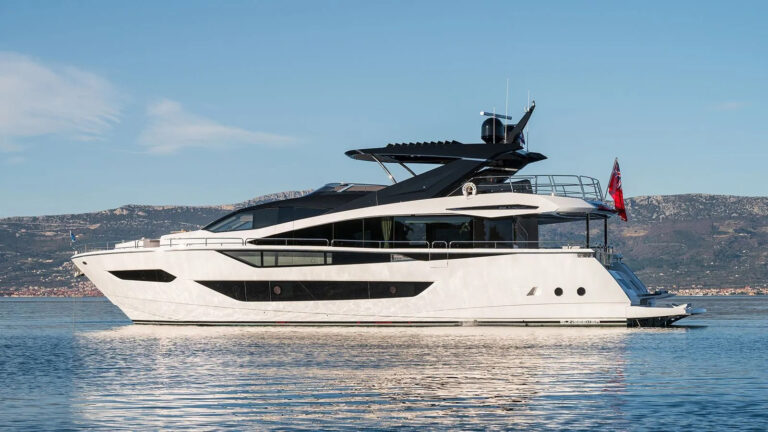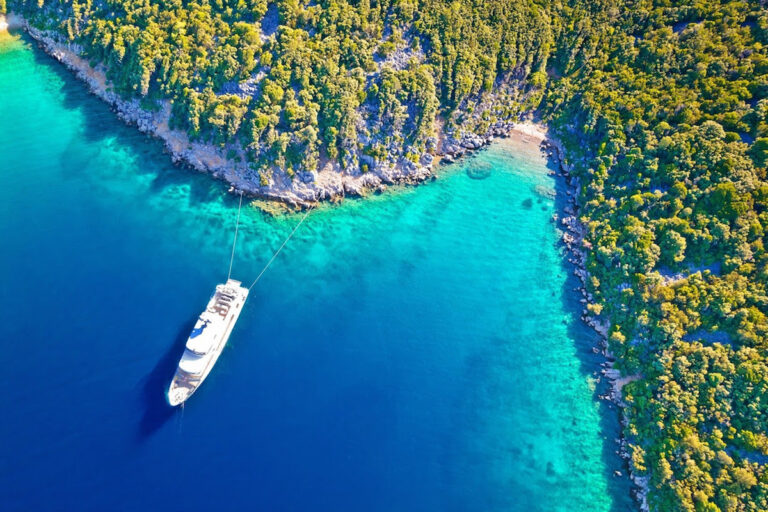You need some distance to get your aesthetic sensibilities around the Lyman-Morse 50 Koan. She’s big for her length, so standing close to her is like sticking your face into one of Monet’s giant canvases. All you’d get is a microcosm. Instead, you’ll want about 50 yards between her and your eyes. A backdrop of granite-salt-and-peppered with the foot-deep greens of Maine’s pine and deciduous foliage-stands this all-white yacht in bold relief, enhancing her powerful bow and sweet sheer. Scatter a handful of lobsterpot-buoy confetti across Maine’s dark waters, and you’ve created a scene worth hanging in any museum of fine art.
Koan is a 50-foot sportfisherman launched by Lyman-Morse this past summer. Geoff Dickes designed her, and Wesmac molded the hull, deck and superstructure. This stock Wesmac 50, a proven hull that sees duty in commercial and recreational guises, is available complete from Wesmac or as a kit. Koan‘s owner, Lee Greenbaum, selected the latter and took her to Lyman-Morse to be finished as a sportfishing yacht. In addition to the custom interior, Lyman-Morse molded a new transom and made enough other modifications to feel comfortable in applying its builder’s plate. Greenbaum should be pleased with his choice of finishing yard-Koan is simply and beautifully done, inside and out.
She’s likely to be a great sea boat, too. Her christened name has its roots in the Zen discipline. A Koan (pronounced “KOH-an) is a paradoxical statement used to induce a sense of calm during meditation, and this stout 50-footer promises to engender the same in her captain and crew. Greenbaum, who expects to spend a great deal of time fishing offshore, will thank her when the weather turns snotty and she’s two days from port.
Pure heft lends a great deal to this boat’s comfort at sea. Bashed by big seas, heavy boats pitch, heave and roll more slowly than do light ones. These slower accelerations take less of a physical toll on crew, delaying the extreme fatigue that robs them of their ability to perform effectively over a relatively long period of time. The shape of the bottom shares responsibility for Koan‘s seakindly manners. Dickes drew the boat to stay in contact with the water. She has a steep entry, a shallow-but straight-sweep in the run and a long keel of modest drag (deeper aft than forward). At their deepest, the forefoot and keel have about the same draft. The prop spins in a large aperture right forward of the rudder, giving the yacht relatively quick and positive responses to steering corrections. The rudder attaches to the keel above and below the prop aperture, so the pilot won’t have to worry much about snagging pot warp.
Intelligently made compromises mean the difference between a boat the owner loves and one he merely tolerates. In trading stratospheric top speed for a cushy ride, Koan‘s owner has to live with extravagant fuel consumption near the top of the yacht’s speed range. At a cruising rpm of 2100, Koan‘s Caterpillar 3412 burns nearly three times more fuel than it does at 1500 rpm.
All this talk of seakindliness seems silly when I reflect on the conditions during my sea trial.
Nature held her breath in anticipation of the afternoon thermals, and St. Georges River was as smooth and shiny as a silk tablecloth at the queen’s banquet. A couple of outboard-powered clamming skiffs wrinkled the surface as they headed for a launching ramp nearby. Koan‘s massive Cat thundered to life, and Cabot Lyman, the yard’s owner, appeared to skipper the sea trial.
Although lobstermen have worked single-screw boats for nearly a century, owners of sportfishermen generally prefer twins, in part for the maneuverability they provide. Koan‘s big prop and powerful bowthruster, however, nearly make a second engine redundant. Manufactured by Teignbridge in Canada, this five-blade prop takes massive bites of water, even under slow way, and directs the flow over the large rudder, authoritatively booting the stern to port or starboard as you desire. A punch from the bowthruster reduces the turning radius to little more than a boat length. Lyman moved Koan off the dock against the current, using the prop walk in reverse and the bowthruster-neat as you please.
Out on the river, throttle open to the stops, Koan gathered speed as though she were a dowager hurrying through the lobby to make “curtain up at the opera. Though she’s not an Olympic sprinter, her gathering thrust is satisfying enough. Top-speed runs are a foolish exercise, because she appears to be so much happier at 2100 or 1800 rpm-dropping 4 and 6 knots, respectively, from max. In high-speed turns, Koan dipped her inside shoulder and carved a graceful arc. We crossed our wake a couple of times to simulate a seaway, and Koan plowed through as if to say, “You must be joking.
Seated on the flying bridge at the centerline helm, I could see enough of the bow and stern to know exactly where the boat was in relation to her surroundings. Placing the helm at the after end of the flying bridge freed up a substantial amount of forward space, which contains a U-shape settee with cavernous stowage bins beneath. An air-conditioning unit dedicated to the bridge resides in a hollow behind the fascia. Koan‘s bridge also has a sink and refrigerator near the helm, plus a freshwater washdown system.
Redman Marine in Saco, Maine, fabricated the tubular aluminum structure for the bridge’s hardtop, and what a fine piece of work it is. When I first approached the ladder to the flying bridge, its steepness intimidated me-it’s a bit shy of perpendicular to the deck-but when I ascended, I discovered a handhold in all the right spots.
Features in and around the cockpit reinforce Koan‘s mission as a serious fishboat. I counted six rocket-launcher rodholders, a bait cooler on the port side with a prep station opposite, two massive fishboxes under the cockpit sole and a transom door big enough to boat Moby Dick. A 600-pound-per-day ice maker feeds the fishboxes, keeping the catch fresh during the slog back to port. I found most of the rod and reel stowage secure and dry under the settee in the saloon.
Long gone are the days of manly, Spartan accommodations aboard offshore fishing machines. Men like to blame their wives and children for the comforts, but the truth is, everyone benefits from comfortable berths, showers, refrigeration, air conditioning and entertainment systems. Koan has her share of high-quality amenities: a Miele washer/dryer, Sub-Zero drawer-style refrigerator and freezer, Gaggenau electric cooktop, Bose sound system, TV and Headhunter toilets.
Koan has to be a floating power station to supply juice to her gadgets. In addition to a 32kW generator, she has 24/12-volt DC, a converter and two 50-amp shorepower cords. The electrical panel, at the inside helm, is one of the finest I’ve seen. Every connection is labeled at the panel and at the terminus, and the wiring is so tidy it’s artwork. This obsessive tidiness carries over into the machinery space beneath the cockpit and into the engineroom amidships, making the job of ship’s engineer more desirable than not.
Mahogany joinerwork in the saloon and teak everywhere else give Koan an invitingly warm interior-in the traditional style. Removable panels upholstered in off-white ultrasuede adorn the overhead and contribute to the noise attenuation throughout the yacht. Large windows all around the saloon flood the interior with natural light and eliminate the closed-in feeling many convertibles of this size give me.
Among the practical touches below, my favorites were the dry-mounted doorframe, allowing relatively easy removal of the washer/dryer; and the power-operated berth in the forward stateroom. My least favorite feature in the accommodations was the portside guest stateroom. The upper berth seemed too close to the overhead, and the lower too close to the upper. A big person flopping about in either berth could wedge into place.
Such are the compromises of a custom yacht. Koan is a fine boat that ought to serve her owner well for many years to come.
Contact: Lyman-Morse Boatbuilding, (207) 354-6904; jb@lymanmorse.com; www.lymanmorse.com. For more information, contact: (866) 922-4877; www.yachtingnet.com/yachting/productinfo.









